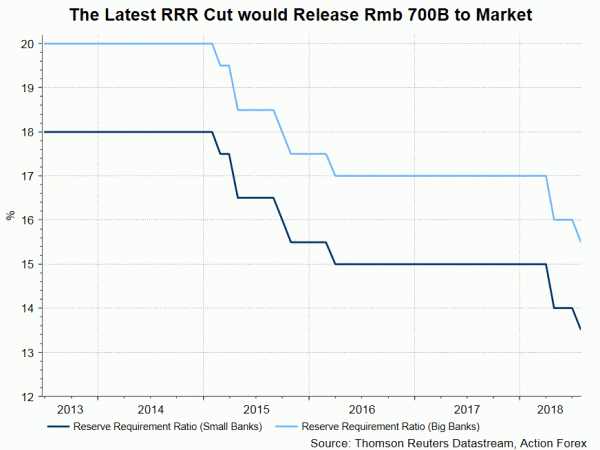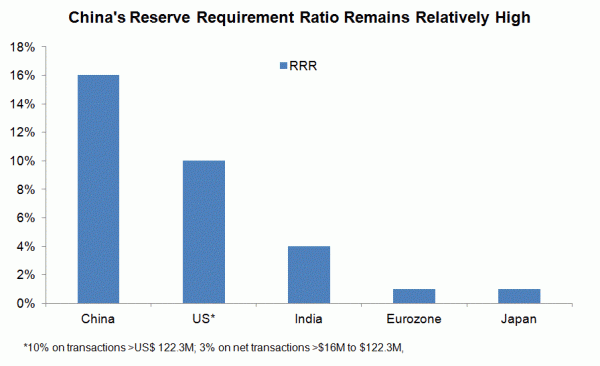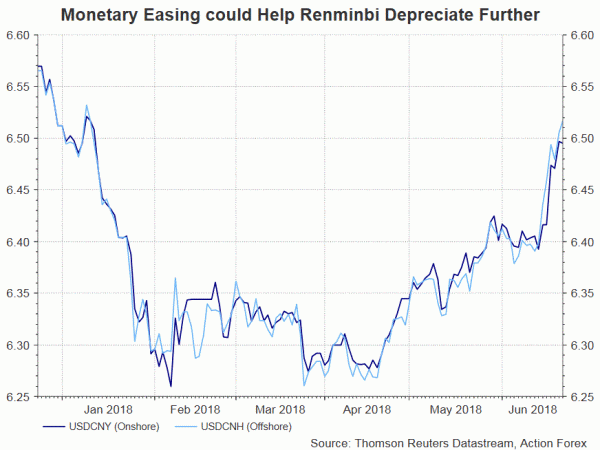Yesterday, PBOC announced a -50 bps reduction in reserve requirement ratio (RRR) for commercial banks. The move, effective from July 5, aims at easing the tightening in credit condition with the injection of about RMB 700B of liquidity to the market. The decision came in line with our assessment that China, struggling with growth moderation and intensification of trade conflict with the US, would have to adopt a more accommodative policy, with RRR cut a usual tool adopted by the Chinese government. Fed’s gradual rate hike, ECB’s completion of QE later in the year and a more hawkish BOE have contributed to a less easy global monetary environment. While this, together with the elevated debt environment (the need to deleverage) in China, suggests the Chinese government might actually need to adopt a less accommodative policy, the rapid deterioration in economic activities in April and May is alarming and has forced the government shift its focus from deleveraging to growth stability. We expect this dilemma would continue to haunt the government in coming years. A mishandling not only would cause disaster in the world’s second largest economy, but also the world.
“Biggest” RRR Cut in 1H18
The lately announced RRR cut applies to nearly all commercial banks. Yet, the liquidity hence released would benefit certain areas. RMB 500B of which would be injected to 17 large banks (including the big 5 state banks and 12 joint-stock banks) for their use in debt-to-equity swaps to “prudently push forward structural deleveraging”. The remaining RMB 200B would be released to postal savings banks, city commercial banks, rural commercial banks and foreign banks, for their financial support to small- and micro-sized enterprises. PBOC would also indicate how the banks use the funds to support debt-to-equity swaps and small- and micro-sized enterprises financing in their macro-prudential assessment (MPA)
Compared with previous RRR cuts, in January and April this year, the size of the latest reduction is bigger in terms of liquidity injection. Announced in September 2017 and took effect in January this year, the selective RRR cut for banks that meet certain criteria for lending to small business and the agricultural sector, released about RMB 450B to the market. Moreover, the 100 bps RRR cut in April released RMB 1300B in total but RMB 900B of which was used to replace some MLFs. As such, a net of about RMB 400B of liquidity was injected at that time.
Striking a Balance between Easing and Deleveraging
As we have reiterated in previous China Watch reports, PBOC has shifted its focus to a monetary policy stance with slight easing bias, in order to stabilize growth. We also cautioned that the easing bias might intensify as driven by US- China trade conflict. The latest RRR cut has confirmed our view. However, don’t forget the elevated debt and shadow banking problems remain live. China’s Xi Jinping reinforced in early April the firm stance on “structural deleveraging”, settling different deleveraging objectives for different types of debts and debtors. This was echoed by Guo Shuqing, PBOC party secretary and chairman of the CBIRC, earlier this month. He placed the emphasis on the deleveraging of SOEs and local governments. The question arises here is: How can one adopt monetary easing while pledging to deleverage? We expect China to do it via regulatory measures.
The merger of China Banking Regulatory Commission (CBRC) and China Insurance Regulatory Commission (CIRC) in March is a move to concentrate the regulatory power and improve regulatory coordination. Meanwhile, the Ministry of Finance over the past few months announced measures to prohibit state-owned banks from providing any form of funding to local governments and restrict corporate and financial institutions that borrow medium- to long-term foreign debt from requesting or accepting guarantees from local government. The government has also launched the “Guidance Opinions Concerning Standardization of Asset Management Operations by Financial Institutions” in April in order to contain the risk in the financial system.
Under the environment of growth slowdown, escalation of US- China trade conflict and elevated systematic risk, we expect PBOC to adopt more RRR cut in coming months in order to assist SMEs which struggle to survive US tariffs and to stabilize growth, while regulatory measures would be resorted to handle deleveraging of the financial system.















